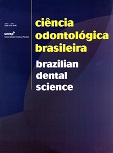Thermal curves of acrylic resins in microwave curing
DOI:
https://doi.org/10.14295/bds.2005.v8i2.385Abstract
The use of microwave polymerization on acrylic resins is a clean and easy method to make complete dentures. It is observed that this kind of process may cause a higher porosity when compared to the conventional heated water bath, probably because of the excessive temperature increase. The objective of this study was the qualitative observation of the thermal curves generated on acrylic by the application of microwave energy in different polymerization cycles. Wax model dentures were reproduced, resulting in four specimens, within each one 7 thermocouples were positioned, having different reading sites of the specimens while the resin was polymerized in a conventional microwave oven. Four cycles were used: 1) three minutes at 475W; 2) 13 minutes at 95W + 1,5 minute at 475W; 3) three minutes at 475W with 150ml of water; and 4) seven minutes at 95W + seven minutes at 95W. The thermocouples were linked to data acquisition equipment, resulting in time-versus-temperature charts. It was concluded that lower power settings led to lower temperature increases. The use of minimum water load caused lower temperature peaks. The used method has a great value for temperature readings when polymerizing microwave acrylic resins.Downloads
Downloads
Published
How to Cite
Issue
Section
License
Brazilian Dental Science uses the Creative Commons (CC-BY 4.0) license, thus preserving the integrity of articles in an open access environment. The journal allows the author to retain publishing rights without restrictions.
=================




























